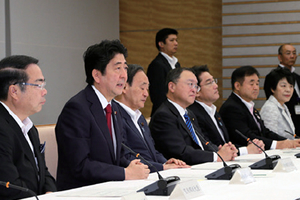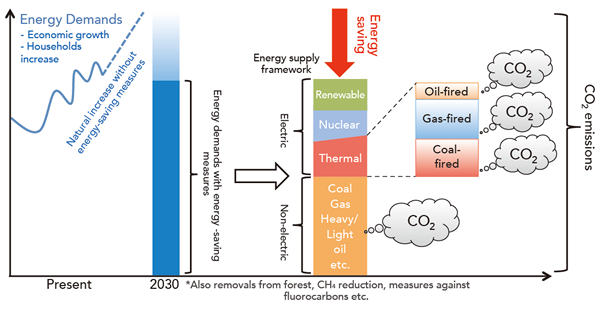Current topics
Japan Submits the Intended Nationally Determined Contribution (INDC)

The 30th Meeting of the Global Warming Prevention Headquarters
According to the decision at the Conference of the Parties (COP), every party is required to submit its INDC that sets the reduction target of greenhouse gas emissions after 2020.
Japan finalized the INDC at the meeting of the Global Warming Prevention Headquarters on July 17 and submitted it to the secretariat of United Nations Framework Convention on Climate Change (UNFCCC).
In its INDC Japan sets the target of 26% reduction by FY2030 compared to FY2013 (25.4% reduction compared to FY2005) based on the amount of domestic emission reductions and removals assumed to be obtained (the reduction target of energy-originated CO2 in commercial and residential sectors by FY2030 is 40% compared to FY2013).
This is a feasible target, ensuring consistency with its energy mix, making bottom-up calculation with concrete policies and measures, and taking technological and cost constraints into adequate consideration. Moreover, considering the rate of reductions, the reductions per GDP/Capita etc. in a comprehensive manner, Japan's target is ambitious enough and bears comparison with the other parties' targets.
Japan will continue to make a major contribution to the agreement on the new international framework at COP21, which will be held at the end of this year.
Also, in accordance with the agreement on the new international framework at COP21, Japan will formulate the national Global Warming Prevention Plan at the earliest time and implement measures based on the plan.
More Information:
Environmental Issues Addressed at the G7 Summit in Elmau

Schloss Elmau main entrance (Photo: Wikipedia)

In June, the G7 summit was held in Elmau, Germany to address complex international, economic and political issues on hand, and the environmental issues were high on the agenda. Regarding climate change, the G7 leaders affirmed their strong determination to adopt at the Climate Change Conference in December in Paris this year (COP21) a protocol, another legal instrument or an agreed out come with legal force under the United Nations Framework Convention on Climate Change.
They also emphasized on the need to decarbonize the global economy and to reduce global greenhouse gas emissions at an upper end of the latest IPCC recommendation of 40-70% by 2050 compared to 2010.
They also reaffirmed their commitment to the elimination of inefficient fossil fuels subsidies and to the effective implementation of policies and actions including carbon market-based and regulatory instruments.
We consider these commitments by the G7 leaders as a major step forward for solving climate change problems.
They also mentioned the Post 2015 Development Agenda and affirmed their commitments to achieving this Agenda, which will be adopted at the UN Summit this September and integrate the three dimensions of sustainable development - environment, economic and social - in a balanced manner.
The importance of improving the resource efficiency and the establishment of the G7-Alliance on Resource Efficiency as a forum to share knowledge and create information networks and the marine litter were also addressed.
In 2016, Japan will lead global-level discussions by hosting and chairing the G7 summit in Ise-Shima and the G7 Environment Ministers' Meeting. As the summit chair and a member of G7, Japan will be committed to solving these issues.
More Information:
G7 Summit Leaders' Declaration
- Strong determination to adopt at COP21 a protocol, another legal instrument or an agreed outcome with legal force under UNFCCC
- Decarbonisation of the global economy over the course of this century
- The upper end of 40 to 70 % GHG reductions by 2050 compared to 2010
- To make GCF fully operational in 2015
- Establishing the G7-Alliance on Resource Efficiency
- G7 Action Plan to Combat Marine Litter
- To integrate the three dimensions of sustainable development - environmental, economic and social - in a balanced manner
Eco-Life Fair 2015
The Major Event of the Environment Month

Participants trying to make Furoshiki (Japanese wrapping cloth) bags: People at all ages enjoyed the workshop.

Large crowd at the Fair: The event was a huge success.
June 5 is the Environment Day, and the entire month of June is also designated as the Environment Month in Japan. During this period, the national government, prefectures and government-designated cities held about 1,400 environment-related events in total. Eco-Life Fair, a major event of the month, has been held through the cooperation between the Ministry of the Environment, related local governments, related corporations, industrial groups, companies and NGOs since 1990.
This year, the Fair was held in Tokyo for two days on Saturday, June 6 and Sunday, June 7 under the theme "We want to protect this beautiful Earth." The goal of the event was deepening visitor's understanding and awareness of the environmental issues including the global warming measures, conservation of biodiversity, promotion of 3R and restoration and recovery from the earthquake and encouraging the visitors to take action to address such issues. This year's event recorded 116,000 visitors, which were the most in the event history.
Environmental Minister Mochizuki joined a live talk show which was open to the public and broadcasted on radio, and he emphasized the importance of environmental conservation activities saying, "We should be more conscious of the fact that human beings receive benefits from a variety of organisms, and we need to protect our beautiful earth for the next generation."
At over 80 exhibition booths, the visitors at all ages enjoyed hands-on exhibits and learned about the environmental conservation.
We will continue to promote similar events that people can learn about the environment with enjoyment in every part of the country.





